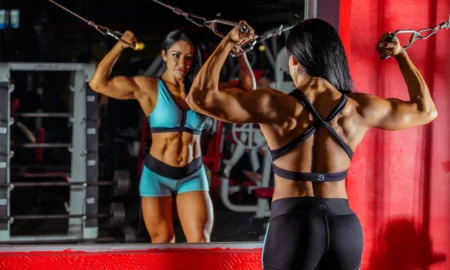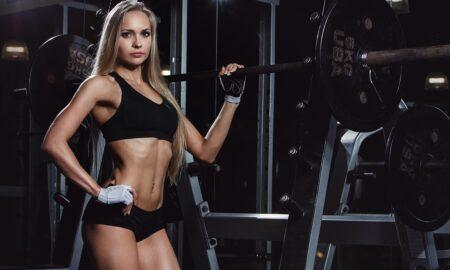“So, what’s wrong with how Yiannis and Stelios train?” you may have asked after reading the first installment of this series last month. If the way you train works well for you, stick with it. But if it isn’t working well, adopt a new regimen.
How the Grimm brothers trained in the two workouts I outlined is similar to the way many people train. Let’s look at what was wrong with those workouts. Some of it may resonate with your own training.
The cable crunch isn’t a bad exercise if it’s done correctly, but the brothers’ rep speed was too fast; they thudded into the top position of each rep and hyperextended their backs and then whipped themselves down on each rep. The stress on their abs was minimal, although they were using a substantial weight on the stack. It was a lot of effort to barely work their abs, but it did irritate their lower backs.
What a sham their quads workout was. The Smith machine can be very harmful to the lower back and the knees. If your feet are well forward, you especially put your lower back at risk, and if your feet aren’t well forward, you especially put your knees at risk.
You should lean forward when you squat with a barbell, but you shouldn’t round your back. Either squat properly with a barbell, or don’t squat at all. Forget the Smith machine for squatting. If you can’t squat properly with a barbell, use the leg press instead. And after your warmup sets, work hard on the leg press. I rarely see people train hard and correctly on the leg press. As soon as the intensity starts to crank up, they invariably put their hands on their thighs to help out, thus reducing the intensity of quad effort. Use as full a range of motion as is safe—safe for your knees and your lower back.
Perhaps a better alternative to the leg press is the parallel-grip deadlift, which some people still call a trap-bar deadlift. It can be a great exercise, especially for bodybuilders who can’t squat well. It’s especially valuable for home-gym bodybuilders because the required bar is very low cost, whereas a good leg press machine is very expensive.
The brothers’ primary calf exercise was the seated calf raise. While that can hit the soleus hard, it doesn’t do much for the gastrocnemius. (The calf is a group of seven muscles, of which there are two major ones—the meaty gastrocnemius and, beneath, the soleus.) The standing calf raise really hits the gastrocnemius, and it also hits the soleus. Much better to do a single calf exercise that works both major components of the calf than to wear yourself out on an inferior exercise.
Stelios and Yiannis finished their lower-body workouts with three going-through-the motions sets of hyperextensions. They had given up on the deadlift because they couldn’t use correct technique. It was no surprise that they weren’t able to use good technique on barbell squats or deadlifts. With tight calves, tight hamstrings, tight adductors and tight glutes, they were too jammed up to be able to do those movements safely and effectively.
Glaring mistakes continued with their upper-body workout. The T-bar rows gave both of them back problems, especially Stelios. Had they not done such a high-risk exercise to begin with—or at least done a chest-supported version—they wouldn’t have irritated their backs.
No wonder the triceps extensions bothered their wrists—they were using a straight bar. A parallel-hand position, done with a rope attachment, would have made a big difference. And if they’d used a shoulder-width grip on the close-grip bench press, rather than a very close grip, they wouldn’t have further irritated their wrists.
While the “No pain, no gain” mantra may give some psychological solace, it’s at the root of much training foolishness and injury. Of course, you should experience muscular discomfort from hard, safe training, but you should never experience pain. Pain means something is wrong.
At the end of the second workout I observed, the brothers realized that they only really pushed themselves on the small exercises in their routines. It was time they recognized that as a major explanation for why their muscles weren’t growing.
What should Yiannis and Stelios have done instead? They should have trained smart: fewer and better exercises done correctly and with greater effort. In future they should start stretching regularly and safely to produce the flexible bodies that are essential if they are to deadlift and squat with a barbell correctly and effectively.
Then, provided they are sleeping eight or more hours each night, eating as much food as they can without increasing their bodyfat (only quality, nutritious food—not junk) and allowing enough days between workouts for recuperation to take place, they will respond to the stimulation from their training by growing fractionally bigger muscles, which will enable them to get stronger. If they maintain that stimulation-recuperation-progress cycle for long enough, changing their training routines every three months or so, they will grow as big and strong as their genetics will permit.
Next month I’ll start to go through precisely what the Grimm brothers’ should be doing to maximize their bodybuilding progress.
—Stuart McRobert
www.Hardgainer.com
Editor’s note: Stuart McRobert’s first byline in IRON MAN appeared in 1981. He’s the author of the new 638-page opus on bodybuilding Build Muscle, Lose Fat, Look Great, available from Home Gym Warehouse (800) 447-0008 or www.Home-Gym.com.




















You must be logged in to post a comment Login